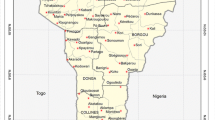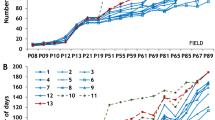Abstract
A field survey/collection trip to Bolivia was carried out in 1994 in order to examine the present status of the leguminous tuber/root crop Pachyrhizus ahipa. The germplasm available prior to the field trip was very limited, only one accession of known origin and two of unknown origin were available for genetic analysis and agronomic evaluation. However, in order to ensure that information on cultivation practices, genetic variation and the need for conservation initiatives would become available to the biosystematic Yam Bean Project (funded by the EU/STD3 Programme), a detailed questionnaire was developed and used in the survey. The field trip succeeded in establishing the urgent need for conservation measurements, the considerable genetic variation available within the extant landraces, and the objectives of any future breeding programme. This species possesses numerous agronomically attractive traits.
Similar content being viewed by others
References
Brücher, H., 1977. Tropische Nutzpflanzen: Ursprung, Evolution und Domestikation. Springer-Verlag, Berlin.
Brücher, H., 1989. Useful plants of neotropical origin and their wild relatives. Springer-Verlag, Berlin.
Burkart, A., 1952. (2nd ed.). Las Leguminosas Argentinas Silvestres y Cultivadas. Acme Agency, Buenos Aires.
Cárdenas, M., 1969. Manual de plantas economicas de Bolivia. Imprental Ichtus, Cochabamba, Bolivia, pp. 1–421.
Fowler, F.J. & T.W. Mangione, 1990. Standardized survey interviewing-minimizing interviewer-related error. Beverly Hills and London.
Girault, L. 1987. Kallawaya. Curanderos itinerantes de los Andes. UNICEF, La Paz, Bolivia, pp. 1–672.
Hansberry, R., R.T. Clausen & L.B. Norton, 1947. Variations in the chemical composition and insecticidal properties of the Yam Bean (Pachyrrhizus). J. Agric. Res. 74, 2: 55–64.
Hawkes, J.G., 1989. The Domestication of South American Roots and Tubers. In: Harris D.R. & G.C.Hillman (eds.), Foraging and farming, pp. 481–503, Unwin Hyman, London.
Herrera, F.L., 1942a. Etnobotanica: Plantas endemicas domesticadas por los antiguos Peruanos. Revista Mus. Nac. (Lima) 11, 1: 25–30.
Herrera, F.L., 1942b. Plantas tropicales cultivadas por los antiguos Peruanos. Revista Mus Nac. (Lima) 11, 2: 179–195.
Mangelsdorf, P.C., 1942. Identifications of plant remains from Nasca and Paracas. Unpublished manuscript, cited from Towle, 1952.
O'Neale, L.M. & T.W. Whitaker, 1947. Embroideries of the early Nasca period and the crop plants depicted on them. Southw. J. Anthropol. 3: 294–321.
Oviedo y Valdés, G.F. de, 1535. Primera parte de la historia natural y general de las Indias, yslas y tierra firme del mar oceano. Cited from deLos Rios J.A. (ed.), 1851–1855. Imprenta de la Real Academia de la Historia, Madrid.
Parodi, R.L., 1935. Relaciones de la agricultura prehispanica con la agricultura Argentina actual. Anales Acad. Nac. Agr. Vet. Buenos Aires. 1: 115–167.
Sauer, C.O., 1950. Cultivated plants of South and Central America. In: Steward, J.H. (ed.) Handbook of South American Indians: 487–543. Smithsonian Institution, Bureau of American Ethnology, Bull. 143, 6.
Sørensen, M., 1988. A taxonomic revision of the genus Pachyrhizus Rich. ex DC. nom. cons. Nord. J. Bot. 8, 2: 167–192.
Sørensen, M., 1990. Observations on distribution, ecology and cultivation of the tuber-bearing legume genus Pachyrhizus Rich. ex DC. (Fabaceae: Phaseoleae). Wageningen Agr. Univ. Papers 90–3: 1–38.
Towle, M.A., 1952. Plant remains from a Peruvian mummy bundle. Bot. Mus. Leafl. 15: 223–246.
Ugent, D., S. Pozorski & T. Pozorski, 1986. Archaeological Manioc (Manihot) from Coastal Peru. Econ. Bot. 40, 1: 78–102.
Weddell, H.A., 1857. Notice sur l'Ahipa et l'Aricoma, plantes alimentaires du Haut-Pérou. Ann. Sci. Nat. Bot. 4: 111–115.
Yacovleff, E., 1933. La jiquima, raíz comestible extinguida en el Perú. Revista Mus. Nac. (Lima) 2, 1: 51–66.
Yacovleff, E. & J.C. Muelle, 1934. Un fardo funerario de Paracas. Revista Mus. Nac. (Lima) 3: 63–153.
Author information
Authors and Affiliations
Rights and permissions
About this article
Cite this article
Ørting, B., Grüneberg, W.J. & Sørensen, M. Ahipa (Pachyrhizus ahipa (Wedd.) Parodi) in Bolivia. Genet Resour Crop Evol 43, 435–446 (1996). https://doi.org/10.1007/BF00123734
Received:
Accepted:
Issue Date:
DOI: https://doi.org/10.1007/BF00123734




